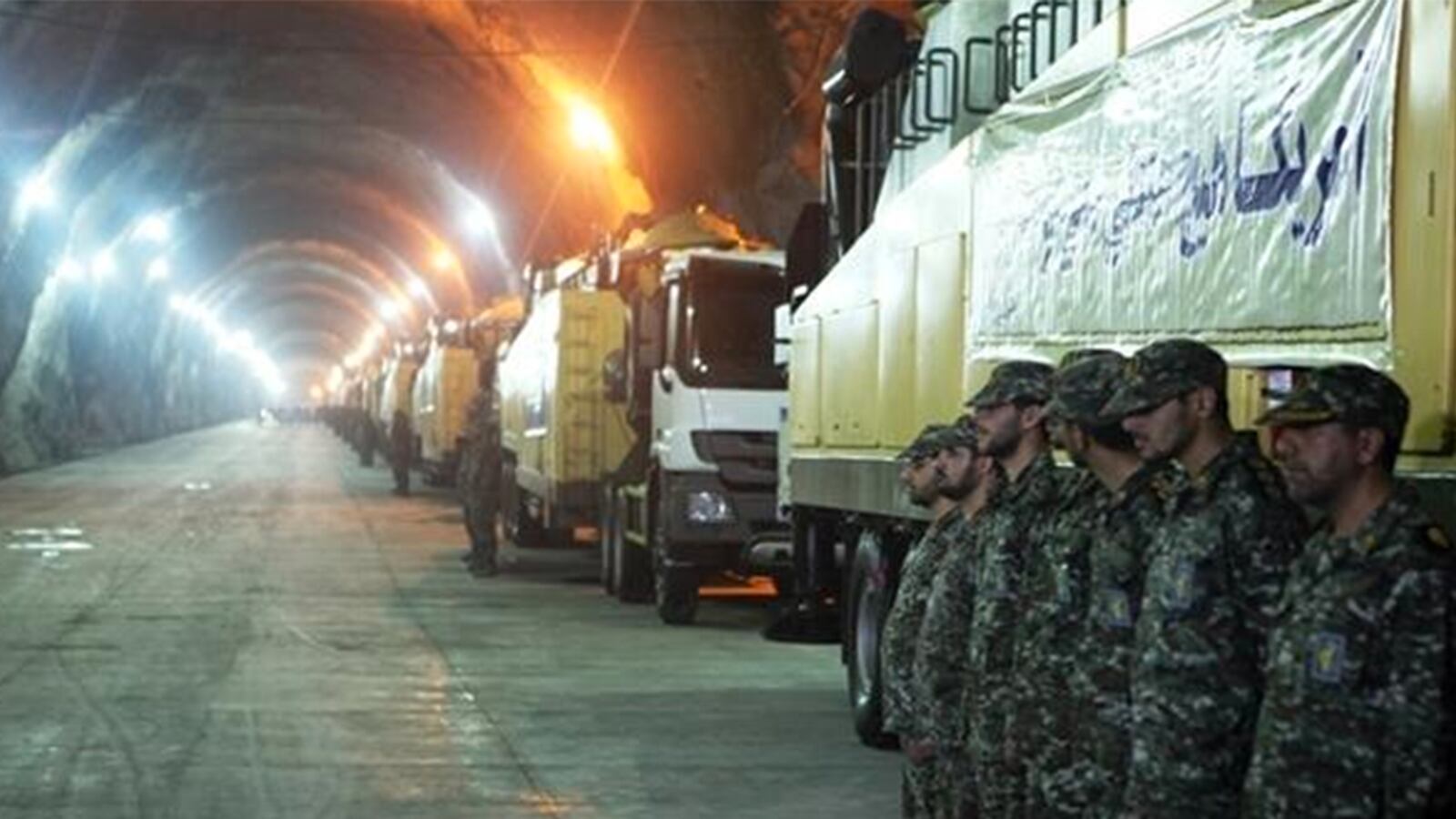Pro-government Iranian news agencies have published photos and videos they claim to depict an Iranian missile facility situated a staggering 500 meters underground in an unspecified mountain range.
“This is a sample of our massive missile bases," Brig. Gen. Amir Ali Hajizadeh, commander of the Iranian Revolutionary Guard Corps Aerospace Force said while showing off the base, according to media reports. "Our power and capabilities are like an iceberg that floats above water and whose tip barely shows above the clear water.”
To put into perspective the alleged depth of the rocket facility, consider that Iran's Fordow nuclear enrichment plant is just 80 meters below the ground and still would be "hard but not impossible" for the United States to destroy, an unnamed U.S. government official told Reuters in 2012.
While details about the alleged 500-meters-down subterranean base are few and difficult to confirm, the bunker and others like it could upset the delicate military balance between the United States and Iran as the two countries move forward on an agreement to limit Tehran's nuclear program in exchange for a gradual easing of economic and military sanctions targeting the Islamic regime.
That's because any facility a quarter mile below ground is way too deep for America's existing bunker-busting bombs to directly destroy in the event Iran reneges on the nuke deal and tries to put atomic warheads on its long-range rockets.
Which is not to say the Pentagon isn't already thinking about ways to indirectly disable such deeply buried targets.
Hajizadeh reportedly granted journalists access to one deep tunnel for the first time on Oct. 13. Among other media coverage, Abas Aslani, the general director of world and foreign policy news at the Tehran-based Tasnim News Agency, Tweeted four photos showing military-style, vehicle-mounted rockets parked in a long, dimly-lit tunnel as men in uniforms stand in ranks beside them. "#Pictures of #Iran's #IRGC #missile base in the mountain & 500 meters underground," Aslani wrote, using the acronym for the Iranian Revolutionary Guard Corps, the most hardline of Tehran's military branches.
"The Islamic republic's long-range missile bases are stationed and ready under the high mountains in all the country’s provinces and cities," Hajizadeh told reporters.
It's unclear whether Hajizadeh was telling the truth—and the journalists touring the tunnel were unlikely to question him. Tasnim News Agency, for one, is a self-described ally of the Iranian regime, dedicated to "defending the Islamic Revolution against negative media propaganda campaign," according to the agency's website.
It's worth noting that Tehran has a reputation for military fakery, even building elaborate but nonfunctional weapons including at least two kinds of warplanes that turned out to be nothing but wooden mockups. In 2008, either the Iranian Revolutionary Guard Corps or one of Iran's government-friendly news publications altered a photo of a missile test to make it seem that the IRGC launched four rockets at a time instead of three.
Even if he was telling the truth, it's hard to know exactly what Hajizadeh meant when he claimed that the missile base is 500 meters underground in a mountain. Was he saying that the bunker is under the surface at a point a quarter mile below the mountain's peak? Or that the tunnel depicted in the photos and video extends a mostly horizontal distance 500 meters into the mountain's base?
The precise meaning matters because it indicates just how much soil and rock lie above the missile facility, between it and the surface. That's the metric that makes all the difference when U.S. warplanes attack and a layer of dirt is all that protects your missiles from the Americans' bombs.
In any event, the timing of Hajizadeh's October 12 underground tour is curious, coming just two days before the Iranian government finally approved the nuclear agreement with the United States and other foreign governments—the effect of which should be to prevent Tehran's rockets from ever getting nuclear warheads.
Of course, just one day earlier on October 11, Iran had test-launched a new ballistic missile in possible violation of a U.N. Security Council resolution barring Tehran from developing nuclear-capable rockets.
It seems that Iran, while willing to tale the nuke deal, is trying to enter into the agreement from a position of strength—and with reminders to the world that it still possesses serious military power.
The United States is taking the same approach. Even as negotiators were working out the final details of the Iran deal, the U.S. Air Force was developing at least two new weapons specifically for smashing underground facilities—plus sophisticated tactics for delivering these weapons to their targets, just in case.
It's just not clear that any of the weapons could put a dent in a facility 500 meters under the ground.
The Air Force takes two parallel approaches to hitting buried bunkers; brute force, and speed. The 15-ton Massive Ordnance Penetrator bomb, a munition so big that only the Air Force's B-52 and B-2 heavy bombers can carry it, represents the brute-force philosophy. Under ideal conditions, the 21-foot-long MOP can reportedly collapse bunkers up to 200 feet below the surface, obviously far short of 500 meters.
At just one ton, the new High Velocity Penetrating Weapon possesses a fraction of the MOP's mass, but makes up for its small size with a rear-mounted rocket that propels the bomb faster than gravity alone can do. The munition "provides improved penetration capability of hard, deep targets with boosted impact," according to an Air Force presentation from 2011 (PDF).
The HVPW, which is still in development, has one major advantage over the bigger MOP. It's meant to fit two-at-a-time inside the bomb bay of the new F-35 stealth fighter. The Air Force possesses just 100 B-52s and B-2s that can haul MOPs, but is buying literally thousands of F-35s that could each carry a pair of HVPWs into battle.
And the Air Force is developing methods for attacking deeply-buried bunkers without punching through every inch of dirt—at least not with just one bomb. For starters, the flying branch already trains its crews to hit underground bunkers with two or more munitions dropped one after the other, each striking the same point and ploughing deeper and deeper into the ground.
Using this method, squadrons of F-35s packing rocket-boosted bombs could probably do a lot of damage, if not burrow all the way into Iran's most heavily protected facilities.
But it's not even necessary to penetrate all the way into every buried bunker. "Current underground facilities are generally comprised of critical utility, communications and air-handling components necessary to perform its mission," Air Force colonel Russell Hart, a B-52 pilot, pointed out in a 2012 paper (PDF) for the flying branch's Air War College. "These components may reside internally or externally to the facility and may connect to an external network or infrastructure."
In other words, even a facility 500 meters underground has entrances, air vents, radio antenna and other vital infrastructure that, by definition, lie at or above ground level. Destroy them and you could isolate a bunker or even suffocate its inhabitants.
So yes, the quarter-mile-deep facility that Hajizadeh claimed Iran possesses could probably resist direct attack, in the event the nuclear deal collapses and the United States decides to strike Tehran's underground rocket bunkers.
But that might not matter. An intact bunker with no air is still pretty useless.






